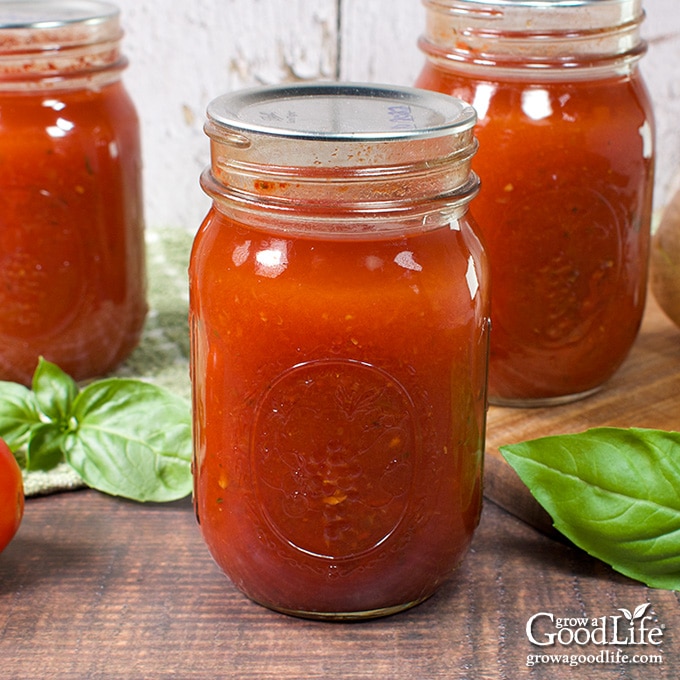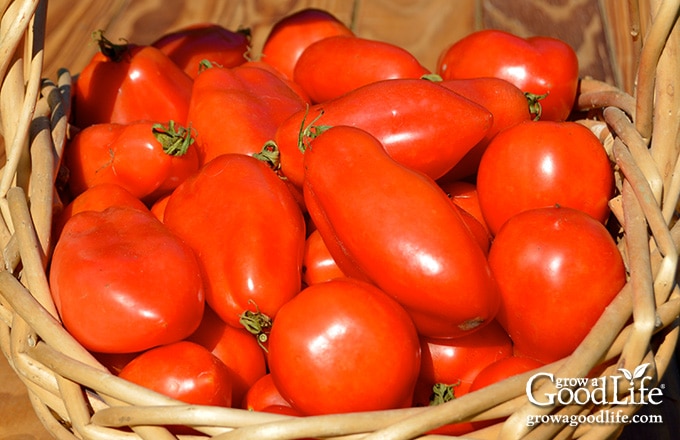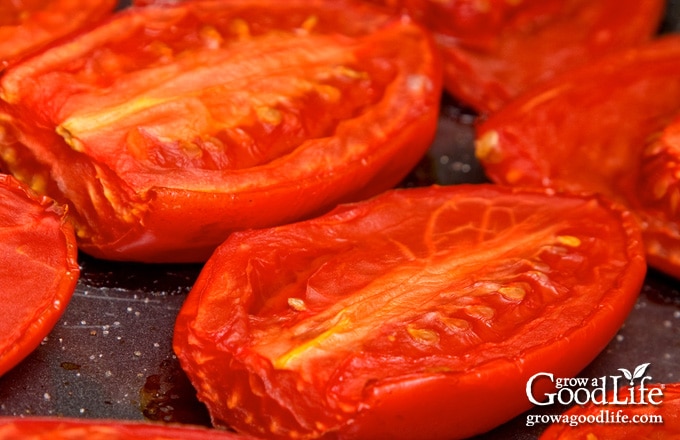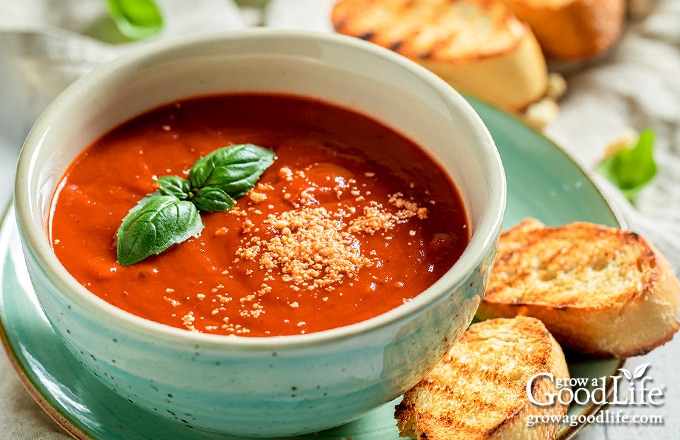[ad_1]
Savor the heartwarming goodness of homemade tomato soup, preserved to perfection with our delightful roasted tomato soup canning recipe. Experience the rich flavors of summer all year round by canning tomato soup.

Indulging in a comforting bowl of homemade tomato soup is a true delight, especially when you can savor its deliciousness all year round. By roasting fresh tomatoes, you can enhance their natural sweetness and intensify their flavors, creating a scrumptious soup.
This recipe will guide you through making and home canning this delectable roasted tomato basil soup so you can enjoy it anytime, even in the coldest months of winter. We will take you through every step, from selecting the freshest ingredients to roasting the tomatoes, simmering the soup, and preserving the goodness for your food storage shelves.
About the Ingredients
You’re in for a treat with this scrumptious soup that features roasted tomatoes, onions, garlic, fresh basil, wine, and chicken or vegetable stock. Let’s delve into the essential ingredients that make this tomato soup so delicious.
Plum Tomatoes
Plum tomatoes, also known as paste tomatoes, are known for their meatiness and low seed content, making them ideal for soups and sauces. Feel free to mix and match different varieties for a unique flavor profile. Here are some types of fresh garden tomatoes to consider using:
- Roma tomatoes are a great choice for making tomato soup. They boast a rich, tangy sweetness that intensifies when roasted, adding robust character to our soup.
- San Marzano are known for their sweet, nutty flavor and low acidity.
- Amish Paste has a full-bodied taste and juiciness, making them a delightful addition to roasted tomato soup, infusing it with an heirloom touch.
- Opalka has a sweet, almost tropical flavor with a hint of tartness. Their unique taste will add a special flavor to your soup.
Quality tomatoes are the cornerstone of a superb tomato soup. So whichever variety you choose, ensure you select healthy, ripe tomatoes at their peak of flavor. Look for firm, unblemished fruits with vibrant colors and a fragrant aroma. Feel free to mix and match with your favorite heirloom and cherry tomatoes for a well-rounded flavor.

Onions
Whether you opt for the classic flavor of yellow onions, zesty red onions, or the mild sweetness of white onions, each will bring its unique taste.
- Yellow Onions: The all-purpose choice in many kitchens, yellow onions lend a robust and classic flavor, serving as a dependable base for our soup.
- Red Onions: Known for their mild peppery taste, red onions add a delightful touch of color and a gentle zing to the soup, enhancing its flavor complexity.
- White Onions: Mild and slightly sweeter than their yellow counterparts, white onions offer a gentle and balanced flavor that harmonizes seamlessly with the roasted tomatoes.
Additional Flavorings
- Garlic: No tasty soup is complete without garlic’s wonderful aroma and flavor.
- Dry White Wine: The wine brings out subtle flavors in the tomatoes, taking our soup to the next level. No wine on hand? No problem! Just use extra chicken or veggie stock instead.
- Stock or Broth: Whether you pick chicken broth, vegetable broth, or homemade stock, it helps tie all the ingredients together and create that velvety, mouthwatering soup.
- Fresh Basil: Say hello to a burst of herby goodness! Fresh basil leaves add bright flavor to our tomato soup, perfectly mingling with the roasted tomatoes.
- Salt and Pepper: The original recipe calls for 5 teaspoons of salt. We found it very salty and have reduced the salt in our recipe to 2 teaspoons or to taste. You can omit it entirely if you are watching your sodium.
- Sugar: We also suggest adding some sugar to help balance the flavors. You’ll appreciate a little more sweetness if you are used to commercially canned tomato soup.
Steps to Making and Canning Tomato Soup
This Roasted Tomato Soup recipe is from The All New Ball Book of Canning and Preserving. Before we dive in, it’s important to know that this recipe requires a pressure canner for safe preservation. We’ll be canning a tomato-vegetable mix without added acid, which means we need those high temperatures to keep any harmful stuff at bay and ensure your soup stays delicious and safe to eat. No pressure canner? No problem! You can simply freeze the soup instead.
You can find the full recipe at the bottom of this article, but here are the detailed steps to crafting this mouthwatering roasted tomato basil soup recipe that is safe for home canning.
Step 1: Gather and Prepare Your Kitchen Equipment
Before you begin, take a moment to gather the following items:
- 2 Large Rimmed Sheet Pans: These will be used for roasting the tomatoes.
- Large Pot: Opt for a 6-quart non-reactive sauce pot to simmer the soup. Avoid cast iron, aluminum, or copper, as they can alter the soup’s flavor, imparting a metallic taste. Instead, use a stainless steel pot or an enamel-coated cast iron Dutch oven for the best results.
- Immersion Blender, Food Processor, or Blender: Select one of these handy devices to achieve the desired smooth consistency when blending tomato soup.
- Pressure Canner with Canning Rack: Since we’re canning a tomato-vegetable mix without added acid, a pressure canner is required to reach the high temperatures necessary for safe canning.
- Canning Jars: You’ll need 6 pint-sized canning jars, or opt for 3 quart-sized jars if you prefer larger servings.
- Lids and Bands: Ensure you have new lids for each jar, while the bands can be reused for an eco-friendly approach.
- Canning Tools: Gather a jar lifter for safe handling, a canning ladle for precise filling, a funnel to avoid messy spills, and a bubble popper to remove any trapped air bubbles.
- Basic Kitchen Supplies: A kitchen scale to weigh the tomatoes, a trusty knife and cutting board, large prep bowls, measuring cups, a large spoon, and plenty of clean kitchen towels for a smooth canning process.
Thoroughly wash the canning jars, lids, bands, and all equipment in hot, soapy water. While cleaning the jars, inspect each one carefully, and discard any that exhibit signs of nicks or cracks. Rinse everything well to remove any lingering suds, and then set everything aside on clean kitchen towels to air-dry.
Familiarize yourself with the specific instructions and features of your pressure canner. Ensure that it’s clean and in proper working condition. You may also find it helpful to review the “Using Pressure Canners” guide on the National Center for Home Food Preservation website.
Step 2: Prepare the Tomatoes
Preheat the oven to 375˚F (190°C). Wash the tomatoes thoroughly under clean, running water. Cut the tomatoes in half and remove the seeds by gently squeezing them. Use a paring knife to remove the cores and any tough parts. Place the tomatoes cut side up on a large rimmed baking sheet or two medium-sized roasting pans.
Sprinkle the tomatoes with about 1 teaspoon each of salt and pepper to enhance their flavor. Roast the seasoned tomatoes in the preheated oven until they become soft, which may take around 30 to 60 minutes, depending on the size of your tomatoes.
Once the tomatoes are roasted, remove the baking sheets from the oven and allow them to cool briefly. When they are cool enough to handle, remove the skins, and coarsely chop them. Save all the flavorful juices, including any liquid in the sheet pans.

Step 3: Prepare the Remaining Ingredients
While the tomatoes are roasting, work on preparing the remaining ingredients. Peel and chop enough onions to yield 2 cups of chopped onions. Mince the garlic cloves. Measure your chicken stock (or vegetable stock) and wine, and chop the basil or leave them whole.
Step 4: Make the Soup
Place a large saucepan or Dutch oven on the stove and add the olive oil, heating it over medium heat.
Once the oil is hot, add the prepared onions, minced garlic, 1 teaspoon of salt, and 1 teaspoon of pepper. Sauté the onions and garlic briefly until they become aromatic, and cook them until they become tender, which should take about 10 minutes.
Add the dry white wine to the pan, using it to deglaze by scraping up any flavorful bits that may have stuck to the bottom. Continue to cook while stirring until the wine evaporates.
Now, add the roasted and chopped tomatoes, along with the chicken stock (or vegetable stock), sugar, and basil leaves. Cover the saucepan and let the soup simmer for approximately 20 minutes, stirring occasionally to prevent sticking.
Once the soup has simmered for the required time, remove it from the heat and let it cool slightly before proceeding with the next step.
Puree the soup to a smooth consistency using an immersion blender or process it in batches using a blender or food processor. Return the pureed soup to the pot and bring it back to a simmer at around 180°F (82°C).
Step 5: Prepare the Jars and Canner
While the delightful aroma of simmering tomato soup fills your kitchen, it’s time to get your canning equipment ready. Follow these steps to ensure your jars are hot and prepped for filling.
Insert the jar rack into the pressure canner. Refer to your pressure canner manufacturer’s instructions to determine the appropriate amount of water needed. For example, Presto requires 3 quarts of water, Mirro suggests 2 quarts, and All American recommends filling it 2 to 3 inches deep.
Fill the jars halfway with water and stand them upright in the canner. Turn on the burner and bring the canner to a simmer of 180°F (82°C) for 10 minutes, and then keep warm until you are ready to fill the jars.
Step 6: Fill and Process the Jars
Lay a dry kitchen towel on the counter. Use the jar lifter to remove one jar from the canner, pouring out the water (you can save it for washing dishes). Place the jar on the towel while leaving the remaining jars in the canner to retain their heat.
Position the canning funnel on top of the jar and use the ladle to carefully fill the jar with the delicious tomato soup, leaving a 1-inch headspace. Run the bubble popper through the soup to release any trapped air bubbles, and use a damp towel to wipe the rim of the jar, ensuring it’s free from any residue.
Center a lid on the jar and position the band over the lid, tightening it until fingertip tight. Return the filled jar to the canner, and repeat the filling process with the remaining jars.
Follow the instructions for your brand pressure canner to seal, vent, heat, and process the jars for the specific times indicated in the recipe below. Once the processing time is complete, turn off the heat, and allow the pressure to return to zero naturally.
Carefully remove the processed jars from the canner and let them cool completely for 12 to 24 hours. After cooling, test the seals of each jar to ensure they are secure and airtight. Wash the jars, then date and label them for easy identification. Store the sealed jars in a cool location, where they will maintain their delicious flavor for 12 to 18 months.

Enjoy Your Delicious Roasted Tomato Soup!
When you are ready to serve, open the jar and pour the contents into a saucepan or pot. Heat the soup on the stovetop over medium heat, stirring occasionally to prevent sticking or scorching. You can add a splash of water or broth if the soup seems too thick.
Taste the soup and adjust the seasonings if needed. Depending on your preference, you can add a pinch of salt, pepper, paprika, red pepper flakes, or other fresh herbs to enhance the flavor.
Once the soup is heated and seasoned to your liking, ladle it into bowls and serve it hot. If you’d like to elevate the taste or texture of the soup, consider adding some optional ingredients. For example:
- A drizzle of olive oil and some heavy cream or full-fat coconut milk can add richness to the soup.
- Freshly chopped herbs, such as thyme, basil, or parsley, can add a burst of freshness.
- A sprinkle of grated Parmesan cheese and a handful of homemade croutons can add delightful textures and flavors.
Enjoy the flavors of your homemade roasted tomato soup, especially with a grilled cheese sandwich! If there are any leftovers, store them in an airtight container in the fridge and use up within a week.

Roasted Tomato Soup Canning Recipe
Savor the heartwarming goodness of homemade tomato soup, preserved to perfection with our delightful roasted tomato soup canning recipe. Experience the rich flavors of summer all year round by canning tomato soup.
Ingredients
- 8 pounds plum tomatoes
- 2 teaspoons salt divided (or to taste)
- 2 teaspoons ground black pepper divided (or to taste)
- 2 cups chopped onions about 2 medium sized onions
- 4 garlic cloves minced
- 1 cup dry white wine or sub stock
- 4 cups chicken stock or vegetable stock
- 1 cup fresh basil leaves tightly packed
- 1 tablespoon sugar optional for flavor
Instructions
Roast the Tomatoes:
-
Preheat the oven to 375˚F (190°C). Wash the tomatoes, cut them in half, and remove the seeds and core.
-
Place the halved tomatoes, cut side up, on rimmed baking sheets or roasting pans in a single layer and season with 1 teaspoon of salt and 1 teaspoon of pepper.
-
Roast the tomatoes in the preheated oven until soft, approximately 30 to 60 minutes (depending on size). Remove from the oven and let the roasted tomatoes cool briefly.
-
When the tomatoes are cool enough to handle, remove the skins and coarsely chop. Save all the flavorful liquid, including any in the sheet pans.
Make the Tomato Soup:
-
Place a large saucepan or Dutch oven on the stove and heat the olive oil over medium heat.
-
Once the oil is hot, add the prepared onions, minced garlic, 1 teaspoon of salt, and 1 teaspoon of pepper. Sauté them briefly until aromatic and cook until the onions turn tender, about 10 minutes.
-
Pour in the dry white wine, using it to deglaze the pan by scraping up any flavorful bits stuck to the bottom. Cook and stir until the wine evaporates.
-
Add the roasted and chopped tomatoes, along with the chicken stock (or vegetable stock), sugar, and basil leaves.
-
Stir to combine, and let the soup simmer for about 20 minutes, stirring occasionally to prevent any sticking. Then remove the saucepan from the heat, and let the soup cool slightly before blending.
-
Puree the soup to a smooth consistency using an immersion blender or process it in batches using a blender or food processor. Return the pureed soup to the pot and bring it back to a simmer at around 180°F / 82°C, and keep it hot as you fill your jars.
Prepare the Canner and Jars:
-
While the soup is simmering, preheat your jars in the canner.
-
Place the jar rack into the pressure canner, and fill it with water per your pressure canner manufacturer’s instructions: Presto is 3 quarts, Mirro is 2 quarts, and All American is 2 to 3 inches.
-
Fill the clean jars halfway with hot water, and then place them on the rack in the canner.
-
Bring the canner to a simmer for 10 minutes (180°F / 82°C). Keep them hot until you are ready to fill them.
Fill the Jars:
-
Lay a towel on the counter. Use your jar lifter to remove a jar from the canner. Pour out the water (save it for washing dishes), and place it on the towel. Keep the remaining jars in the canner so they stay hot.
-
Use your canning funnel and ladle to fill the jar with the hot tomato soup, leaving 1-inch headspace.
-
Remove air bubbles with the bubble popper, wipe the rim to remove any residue, center a lid on the jar, and screw on a band until it is fingertip tight.
-
Use the jar lifter to place the jar back into the canner and repeat with the remaining jars.
Process in a Pressure Canner:
-
Place the lid on the canner and lock it. Leave the vent open, adjust the heat to medium-high, and bring the canner to a boil. Allow the pressure canner to vent steam for 10 minutes, place the pressure regulator on top of the air vent, and let the pressure rise.
-
Once the canner has reached the correct pressure (10 pounds for weighted gauge and 11 pounds for dial gauge pressure canner), set a timer and process pint jars for 50 minutes, and quarts for 60 minutes at altitudes of less than 1,000 ft.
-
Adjust for your altitude if necessary (see chart below), and regulate the heat as needed to maintain a steady pressure.
-
When the processing time is complete, turn off the heat, and let the pressure canner cool down to 0 pressure. Once the canner is depressurized, let the canner cool additional 10 minutes before removing the lid.
-
Spread a dry towel on the counter, unlock the cover, and remove it by tilting the lid away from you so that steam does not burn your face.
-
Allow another 10 minutes for the jars to adjust to the change in pressure. Then, if the jars are still boiling vigorously, let them sit in the canner for another 5 minutes or until the boiling slows.
-
Use the jar lifter to lift jars carefully from the canner and place them on the towel. Keep the jars upright, and don’t tighten bands or check the seals yet. Let the jars sit undisturbed for 12 to 24 hours to cool.
-
After 12 to 24 hours, check to be sure the jar lids have sealed by pushing on the center. The cover should not pop up. The jar failed to seal if the top flexes up and down. Refrigerate it and use it within a few days.
-
Remove the screw-on bands and wash the sealed jars in warm soapy water. Label, date, and store in a cool, dark place for 12 to 18 months. Once opened, refrigerate and use up within a week. Yields about 6 pints or 3 quart jars of roasted tomato soup.
Notes
All times are at an elevation of less than 1,000 ft. Visit whatsmyelevation.com to check your elevation and adjust the processing time if necessary. Make the following adjustments for altitudes greater than 1,000 ft. using the chart below.
Nutrition
Serving: 0.5cup | Calories: 55kcal | Carbohydrates: 9.8g | Protein: 2.1g | Fat: 0.4g | Saturated Fat: 0.1g | Sodium: 342mg | Potassium: 343mg | Fiber: 2g | Sugar: 7.2g | Calcium: 29mg | Iron: 1mg

Good planning is key to a successful vegetable garden
Whether you are new to growing your own food or have been growing a vegetable garden for years, you will benefit from some planning each year. You will find everything you need to organize and plan your vegetable garden in my PDF eBook, Grow a Good Life Guide to Planning Your Vegetable Garden.

[ad_2]
